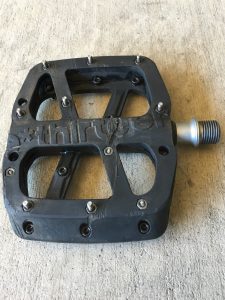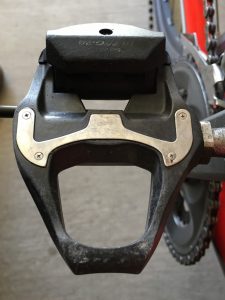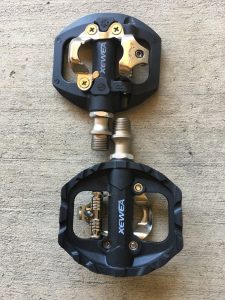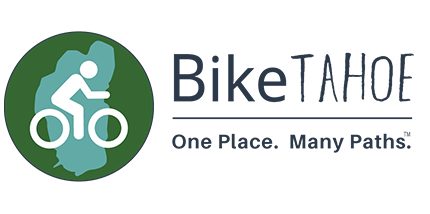Choosing the Best Bike Pedals
Bike pedals play a significant role in bicycling, and choosing the best bike pedals is a decision that can support your riding style, power and enjoyment. Pedals are important because they connect our feet to the bike. They support our stance, balancing and transmitting our energy to the rear wheel. See the complimentary article about how to choose the best bike shoe.
Choosing the best bike pedals is largely dependent on the type of riding activity you predominately do.
There are three basic pedal types: flat/platform, clipless and a hybrid of both designed into the pedal. Let’s take a look at the characteristics of each for choosing the best bike pedals for you.
Flat/Platform Pedals

Mountain Bike Flat Pedal
Flat/Platform pedals have been the most commonly used for decades. You will find them on kids bikes, beach cruisers, and road and mountain bikes. When you buy a new bike, flat pedals come as standard equipment. Typically, these standard equipped pedals are made from a low cost plastic resin material and can accommodate nearly any type of footwear.
For kids and beach cruiser bikes these pedals may be suitable, but as your riding skills and speed increase you will likely want to replace these with a more performance platform.
Performance Freeride and Enduro (downhill) mountain biking has influenced the flat pedal design. Freeriding mountain bikers are traveling fast downhill, going off jumps, riding log features and riding in the bike park. To support these freeride performance maneuvers, riders want more connection to the pedal and also the option to easily alter their foot placement or remove their feet completely off the pedals. To provide these performance options flat pedal construction and designs have replaced inexpensive resin with metal or hardened nylon to increase traction by using claw-like teeth and/or small pins on the pedals. Bike shoes have also evolved with these platform pedals to produce better connection. (see the article on Choosing the Best Bike Shoes).
Clipless Pedals.

Road clipless pedal
Clipless pedals are a bit of a misnomer because we actually clip into them. Clipless pedals are in some ways similar to ski bindings. Using a cleat installed on the bottom of bike shoes, we step into the pedal clip and it clicks in – connecting us. These clips have an adjustable spring tension (like ski bindings) that can be changed to your desired ability for easily twisting out of the binding or tightened to required more strength to disconnect from the binding. The twisting action is done at the ankle by rotating the heel of the foot outward. The bindings have a slight side-to-side movement of about 5 degrees in either direction to allow for the anatomical differences among individual riders.
Clipless pedals are most commonly used on road bikes. Being clipped into the pedals gives the rider about 15-20 percent more pedal power as the rider can pull up on the upstroke – not an option with flat pedals. Road cyclists typically enjoy long endurance rides and get into a pedaling mind-set zone for efficiently cranking out the miles and enjoy the increased power from clipped in pedals.
Clipless pedals are also popular among cyclists who enjoy riding cross-country mountain and gravel bikes for the power efficiency the pedals provide.
Learning to use clipless pedals.

Mountain bike cleat
It’s important to note there is a brief learning period for adapting to having your feet clipped into the pedals and twisting out of them.
Getting ready. First, you will need to have bike shoes that allow you to attach the clip on the soles. Attach the clip to the bottom of the shoe being sure to properly align it along the centerline of the shoe, and fore or aft to place it under the ball of the foot. (If in doubt, get experienced assistance to help align the clip on the shoe).
In the beginning, reduce the spring tension of the binding so it is easy to twist your foot out. You can tighten the tension later as you desire.
Practice. Now practice clipping in and out. I suggest before jumping on your bike and riding, that you first practice safely by getting on the bike and balancing your hand against a wall. This will enable you to maintain balance while you learn clipping in. You will need to learn the foot movement to align the clip and step in, and then the twisting movement to disconnect. Practice this several times one foot at a time so that you feel confident clipping in and out.
On your first ride, I suggest selecting a trail/road with no traffic, or a place like when you practiced in the school parking lot learning to drive a car for the first time. Another safe option is to slowly ride on a spacious grassy area. In this safe space, practice clipping in and out with just one foot at a time, and then the other. Go slow. Continue practicing until your feel confident getting in and out of the binding. NOTE: It is not uncommon to come up to a stop light the first time and forget to clip out of the binding. So practice this movement before launching on a big ride or too far from home.
Dual Pedals

Dual pedal
Dual pedals are a mix of a flat platform on one side and a clip on the other. This pedal type appeals to some riders because it gives them the option to change their pedaling style to adapt to their riding activity – freeride or endurance.
Design Options
Among the pedal types mentioned above, there are several manufacturers in each pedal category. Each manufacturer approaches the connection and performance solution slightly differently.
When choosing the best bike pedal for you, check with your trusted bike shop and friends for their thoughts and experiences appropriate to their understanding of your riding ability, activity and experience.
Have fun, stay safe and enjoy the ride.


